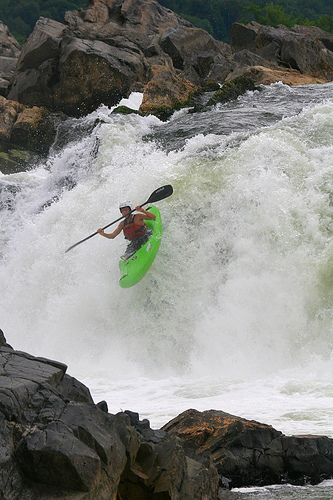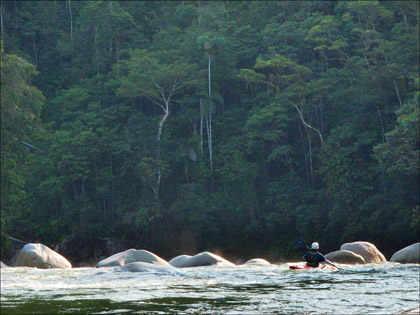 Large ledges typically have a distinct horizon line that precedes them. You can often identify a large ledge by looking at trees below, listening for the loud sound of crashing water, or watching the boater in front of you suddenly disappear. You may encounter ledges in class II on up rapids. A great class II ledge in our area is Snap Falls on Muddy Creek - see picture on the right. On smaller ledges, boaters below will identify when it is safe to run by holding their paddle vertically. On more challenging ledges or those with potential dangers, we typically set suitable safety. When running ledges, avoid the "Old School" habit of holding the paddle shaft above your head and leaning way back. This takes your paddle out of the safe zone - the paddlers box. Leaning on the back of your boat also makes the boat less stable when you land. A better approach is to enter with a little bit of extra speed, plant a very strong last stroke at the lip, and try to lift the front of your boat with both knees. This maneuver definitely takes some practice.
Large ledges typically have a distinct horizon line that precedes them. You can often identify a large ledge by looking at trees below, listening for the loud sound of crashing water, or watching the boater in front of you suddenly disappear. You may encounter ledges in class II on up rapids. A great class II ledge in our area is Snap Falls on Muddy Creek - see picture on the right. On smaller ledges, boaters below will identify when it is safe to run by holding their paddle vertically. On more challenging ledges or those with potential dangers, we typically set suitable safety. When running ledges, avoid the "Old School" habit of holding the paddle shaft above your head and leaning way back. This takes your paddle out of the safe zone - the paddlers box. Leaning on the back of your boat also makes the boat less stable when you land. A better approach is to enter with a little bit of extra speed, plant a very strong last stroke at the lip, and try to lift the front of your boat with both knees. This maneuver definitely takes some practice.
 Waterfalls are really tall ledges. Some are relatively easy to run like Wonder Falls on the Lower Big Sandy. Many others have difficult entrance rapids and shallow landing areas you need to avoid like Great Falls on the Potomac. At the bottom of many falls are upstream and downstream hydraulics centered on the curtain of the falls. Many falls cut into the ledge that forms them and this creates a pocket of air behind them. When considering running a falls, make certain you know where to land and it is deep enough. Depending on the height of the falls, you may wish to land flat (short falls or shallow landing - aka a boof move) or angled entry for tall falls. Notice the example of Great Falls on the Potomac in the picture on the right.
Waterfalls are really tall ledges. Some are relatively easy to run like Wonder Falls on the Lower Big Sandy. Many others have difficult entrance rapids and shallow landing areas you need to avoid like Great Falls on the Potomac. At the bottom of many falls are upstream and downstream hydraulics centered on the curtain of the falls. Many falls cut into the ledge that forms them and this creates a pocket of air behind them. When considering running a falls, make certain you know where to land and it is deep enough. Depending on the height of the falls, you may wish to land flat (short falls or shallow landing - aka a boof move) or angled entry for tall falls. Notice the example of Great Falls on the Potomac in the picture on the right.
 A horizon line often denotes the beginning of a steep drop or ledge, notice the example in the right side picture. If the rapid is known to be safe, I like to cautiously paddle to the middle of the river to get a better look. You can use your back ferry or draw strokes to move laterally to line up for the best position to start the drop. If you can find an eddy close to the ledge, go catch it and get a better look from your boat.
A horizon line often denotes the beginning of a steep drop or ledge, notice the example in the right side picture. If the rapid is known to be safe, I like to cautiously paddle to the middle of the river to get a better look. You can use your back ferry or draw strokes to move laterally to line up for the best position to start the drop. If you can find an eddy close to the ledge, go catch it and get a better look from your boat.
